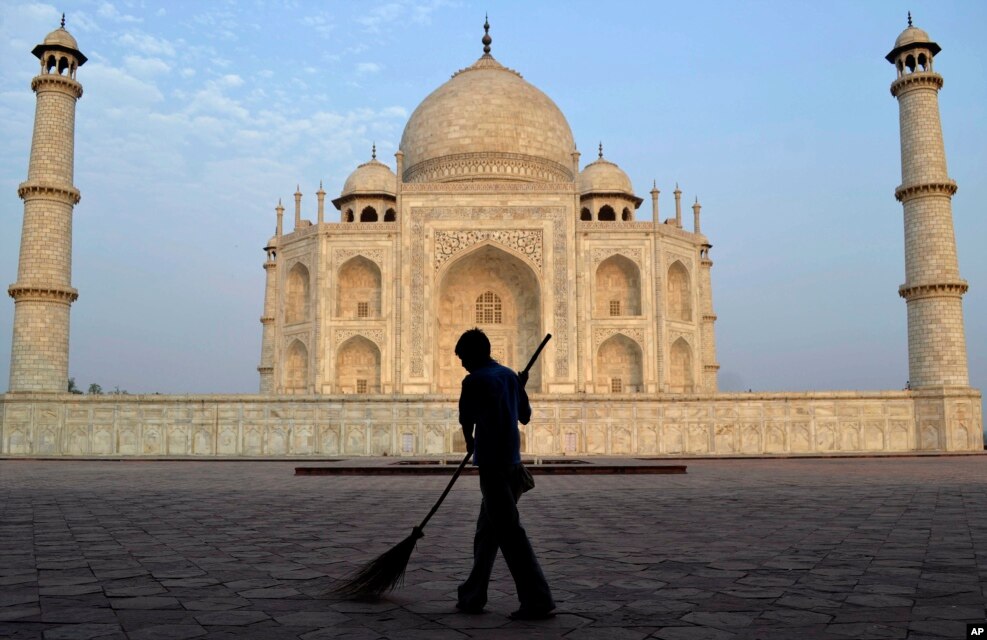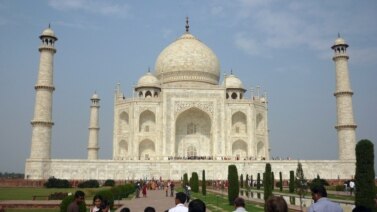
India's world-famous Taj Mahal is facing a new threat: insect poop.
The Yamuna River flows around the Taj Mahal, and the river is heavily polluted.
Large numbers of insects are breeding in the polluted waterway. Officials say the insects land on the Taj Mahal and leave poop behind on its white stone walls.
The insects' droppings are beginning to turn the walls green.
Bhuvan Vikram is the top official at the Archeological Survey of India in the city of Agra, home of the famous building.
He told VOA that, “During the evening time, [the insects] get attracted towards the white [surfaces] and during the night they stay over there and leave those green deposits.”
Workers try to remove the insects' waste. But experts fear heavy cleaning could damage the artwork in the Taj Mahal.
Vikram said workers first discovered the problem last year. But they identified the cause of the problem only recently.
A fly known as the genus Geoldichironomus is the insect responsible for all the droppings. Those insects survive best in the hot weather and in the algae along the sides of the river.
The city of Agra is home to many people and lots of industry. Environmentalists have struggled for years to protect the Taj Mahal's white stone from turning yellow because of air pollution.
Air pollution levels dropped after coal-based power centers and some polluting industries were closed. But the waters of the Yamuna River have yet to improve.
Environmental campaigners like D.K. Joshi say the way to stop this new threat is to save the dying river. He has presented his argument to the National Green Tribunal, an environmental court. Joshi says waste from 52 open drains in the city is poisoning the river.
“Industrial waste, solid waste, all this empties into the river. Millions of dollars have been spent to clean the river, but nothing has happened,” he added.
Experts say ash particles from burnt human remains are part of the problem. For 200 years, people have set fire to dead bodies near the Taj Mahal. The fires are part of funeral ceremonies for the dead.
Ash from the burnt remains is the main source of food for the insects.
Six months ago, the Supreme Court asked city officials to move the funeral area. There was concern that smoke from the fires was affecting the color of the white stone surfaces. But the move has still not happened.
Now city officials are asking people to try more environmentally-friendly funeral customs because of protests from a Hindu group.
Joshi believes cleaning the Yamuna River is possible with a short-term program. “Stop the [waste] from going into the river, improve its flow. It is not difficult, but the will power is not there,” he said.
Vikram hopes this latest threat to the Taj Mahal from insects will get the attention of city officials. He hopes it will get them to clean the river.
But he also worries about the large amount of pressure the rise of tourism puts on the Taj Mahal. Six million people visited the world-famous structure in 2014.
“So much is the amount of dirt that it creates, these are the [problems] of tourism. The tourists, they like to touch the surfaces. For that we are trying to provide some kind of separators,” Vikram said.
I'm Pete Musto.
Anjana Pasricha wrote this story for VOANews.com. Pete Musto adapted her report for Learning English. George Grow was the editor.
Now it's your turn. How do does the government protect famous places tourists like to visit in your country? How does the changing environment affect those places? Let us know in the comments section or on our Facebook page.
Words in This Story
poop - n. solid waste passed out of the body
breed(ing) - v. to produce offspring by sexual reproduction
attracted - adj. caused to go to or move to or toward a place
deposit(s) - n. an amount of something such as sand, snow, or mud that has formed or been left on a surface or area over a period of time
fly - n. a small insect that has two wings
genus - n. a group of related animals or plants that includes several or many different species
algae - n. simple plants that have no leaves or stems and that grow in or near water
environmentalist(s) - n. a person who works to protect the natural world from pollution and other threats
drain(s) - n. something such as a pipe that is used for removing a liquid from a place or container
tourism - n. the activity of traveling to a place for pleasure
